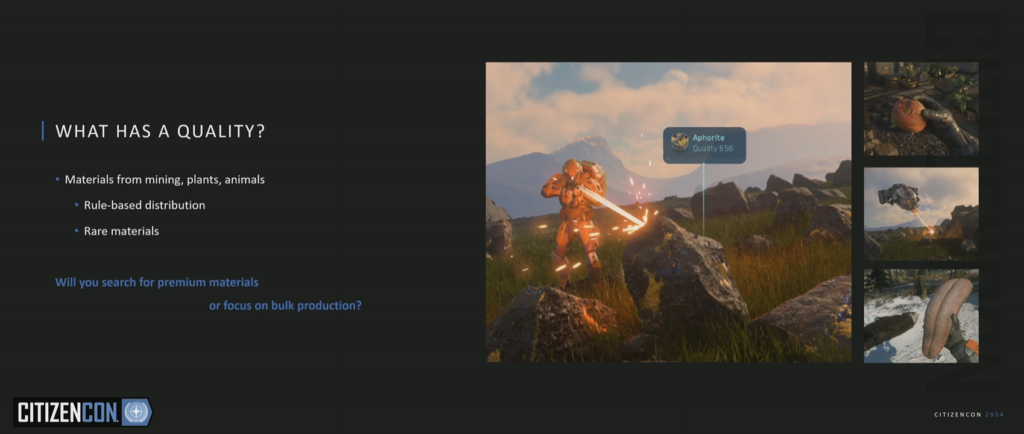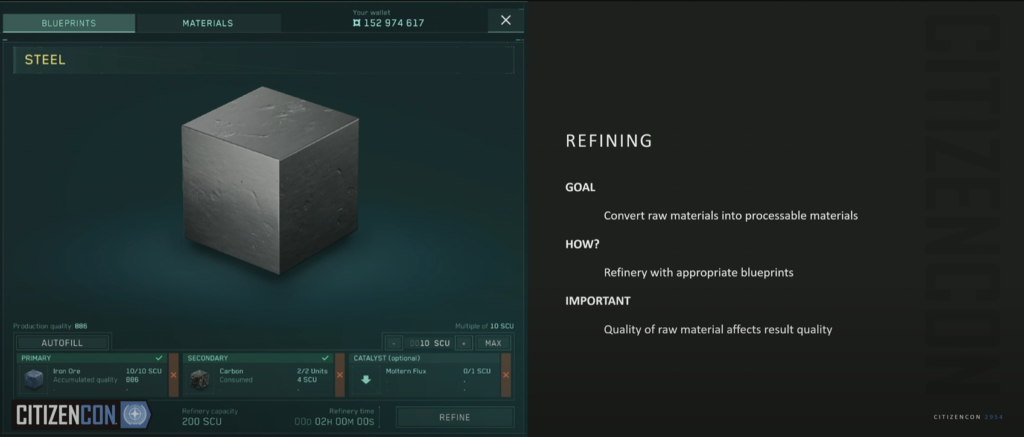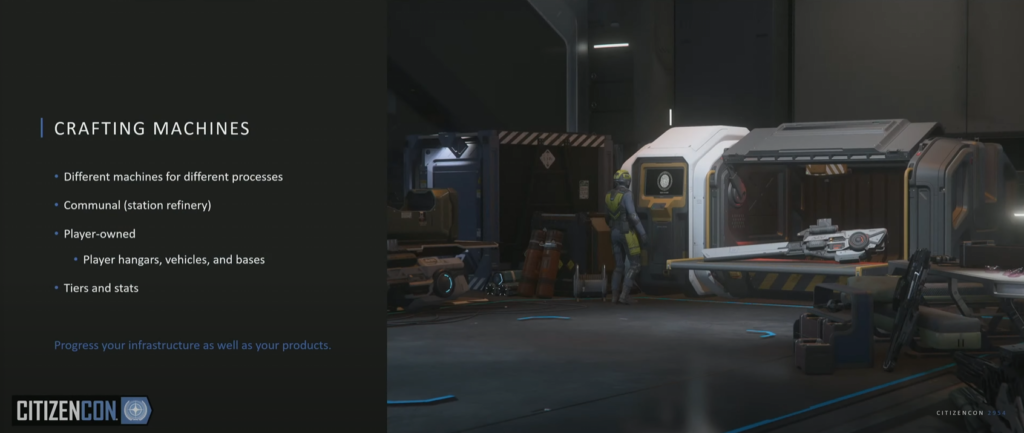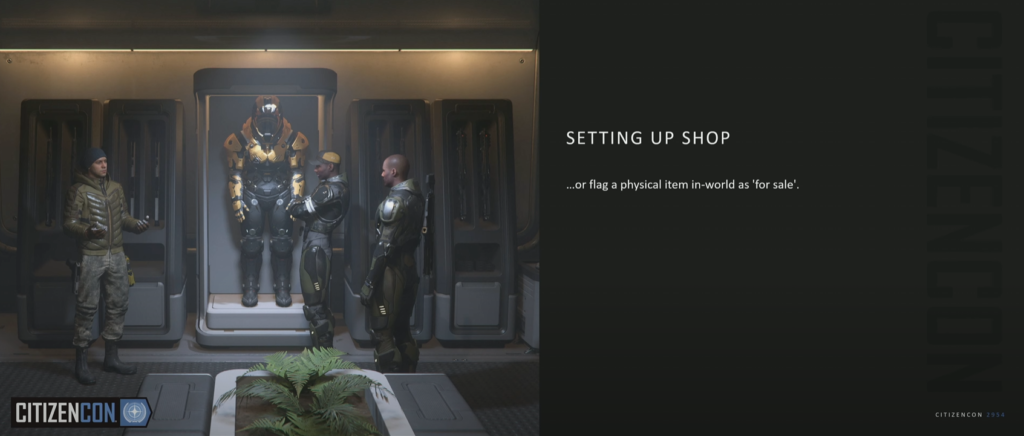
Note: although it was one presentation, I’m going to split up the general crafting loop post and the structure building posts because there’s too much info to put into one post before it starts to get too long even by my standards.
In the current alpha, players have limited persistence. We wake up in random HABS, and all of our stuff is stored “in the cloud” at specific landing zones. It’s only been a few patch cycles since we’ve gotten persistent hangars which belong to us and only us, and which allow us to deploy furniture and crates and other inventory items in a bid to make us feel at home in the game, but every time we log in, we still wake up in a random HAB. Having players feel like they are participating in a world and not just a game is important to CIG, and the best way to do that is to give us all the opportunity to claim a slice of the universe as our own through crafting.

Crafting is a profession, which puts it in-line with the “specializations” that were mentioned in the brief presentation about armor and clothing. It’s insinuated (I’m not sure if it’s stated outright elsewhere) that the clothing and/or armor we wear can help us with our gathering and crafting routines in some as-of-yet undescribed way.
We already have gathering tools such as the Prospector, the Mole, and the ROC, the Pyro MultiTool with OreBit attachment, salvagers like the Vulture and Reclaimer, and access to refineries on select stations, but for the longest time the only game loop using these tools was a game line. All we can do right now is mine or harvest or salvage, refine the materials, and then sell the results; none of the raw or refined materials are actually used for anything.

Being able to sell raw or refined materials will still be available in the future, but eventually all raw materials will have the option to be refined. This includes reclaimed composites from salvaging, and organic materials from wild gathering, farming, or creature hunting, and all of the minable ore. At some point, gas and liquids collection and refinement will enter the picture.

While salability will bring in some quick UEC, the real draw will be to use those materials in crafting professions. We’ll be able to make tools, weapons, armor, clothing, ship components and even ships themselves, and with the stated plan for the crafting system, the items we craft will be varied and potentially better than what we can get in NPC shops.
Blueprints

In order to craft anything, we first need a blueprint (BP to borrow the colloquial from EVE Online). We can acquire these in many ways, with the most general item BPs being easily available (I assume). The more rare the BP, the more difficult they will be to obtain: mission rewards, random finds, or unlocks by earning rep with factions and guilds.
Materials

Although we already have materials (some, anyway) in the game, and since all we can do with them is sell some and refine others, the only real differentiator between any of them is the price that they sell for. With crafting, though, resources will gain the concept of quality. The quality of a resource will have an effect on the values of the stats that the chosen material will impart to a crafted item.

Item Stats

I believe that right now in the alpha, items have stats, but in the original service of simulation, they weren’t anything we could see and besides, with the amount of tweaking being done in the name of “balance”, knowing an item’s stats right now would be an imprecise metric.
With crafting, items will be gaining stats that we can see. Each type of item will have it’s own set of stats. These stats will be determined by the type of material used, and the quality of the material used.

I’m going to break character and jump into editorial mode for a second and invoke the name of Star War Galaxies. If you were an SWG player and enjoyed that game’s crafting as much as I did then the plans that CIG has laid down in this presentation should be music to your ears.

Each BP is going to require specific classes of materials. This means that a gun might require “a metal” and “a plastic”. Which metal and which plastic is not mandated by the BP, so your choice of which refined material to use to satisfy those requirements will affect which stats are updated or added. After that, the quality of the material matters when determining the stats value, with rarer materials with higher quality having a more outsized effect on the value. Still, it was mentioned that lower quality materials will have a place in crafting even when higher quality materials are on hand. All of this means that we can decide which stats to focus on by choosing materials that impart those stats, decide how much of a stats boost we want by seeking out the quality of materials we want to use, and the result will be a unique item that’s a sum of its parts.

Research
As if mixing and matching resource type and quality wasn’t enough, we can boost the base stats of the blueprint through research.

Making higher tier items from researched BPs will require different and more advanced materials, but the end result is going to be even better than lower tiered items. It will also allow for higher tier items to be more specialized through the requirement of these higher end materials than items of lower tiers.
Most items can be made in tier 1, 2, or 3, but ships can be crafted up to tier 5.

Yes, crafting a ship at tier 5 will make it better than what we have from the pledge shop and better than what we can get in-game from NPC vendors.
That kind of sucks if our pledged items are stuck at tier 1, so CIG is allowing us to upgrade existing items through the tiers. This is done through an upgrade BP (I am not sure if this is a regular BP that has been researched, or a totally different type of BP used specifically for upgrading existing items).
We then saw some videos which showed the benefits of higher tier items, starting with a gun at both tier 1 and at tier 3. Notice the hit-patterns on the far wall: tier 1 has a greater recoil lift than the tier 3 version, contributing to accuracy.

We also saw that the spooling time on a tier 3 QT drive was faster than that of a tier 1 (my MSR needs this update). This means that when preparing for an in-system long-distance trip, we complete the “get ready” phase faster which saves both time and, potentially, asses.

Crafting Loop
1. Get Blueprints
BPs can be found by searching crates in mission areas and in the open world, bought from NPC vendors (at least; no official word on if we can buy and sell them ourselves, though it was mentioned they could not be stolen or traded), or earned as mission rewards or through reputation gain unlocks.
BPs are not physical items; they are digital, which means that unlocking a BP makes it yours forever, accessible through your crafting library. This also means that BPs are not used up during the crafting process.
2. Research
Research requires a research databank which is something that was not explained. We will use a current-tier BP and upgrade it to the next tier via this process. This also does not consume the original BP, so we will always have access to the lower tier BPs even after upgrading them.
The upgrade process isn’t as straightforward as just providing materials, though:

The goal of this process is to route players into more specialized professions as the amount of work required to boost a BP tier will no doubt only get more difficult the higher the tier we target. In the above example, a player would spend a lot of time crating 100 VOLT pistols. They would also need to spend time finding the right material for Fire Rate with a quality that would boost that stat over 1,100. This would be easier for org-centric players who have a wide resource pipeline, though there might also be opportunities to buy required materials from other players. Then, of course, there’s the material cost itself (RMC is gained from salvaging and is easy to come by) as well as a time to research which, in the above case, is the better part of 4.75 days or so.
3. Finding Resources
We already have the ability to mine, salvage, harvest, and hunt, so the means by which we gain these resources, and their sources, will expand to make this part of the crafting loop more diverse. It was mentioned almost as an aside that if we want the best quality materials we need the “best quality radar” which implies that at some point, our ship scanners will be reporting back the quality of material zones we encounter.

4. Refining
Refining in the current system only requires that players take their raw materials to a station with a refinery, choose the processing method (which costs aUEC and time, and varies in the quantity of refined materials produced), and wait for the job to finish. In the new system, refining will require refining BPs that take a primary material, a secondary material, and an optional catalyst. The quality of the primary material determines the quality of the refined material, the secondary material has an impact on quantity of the resulting material and the time the process takes. The catalyst can help speed up the process further.

In the above example, the quality of the Carbon in the secondary material slot will determine how much Carbon is needed: lower quality Carbon will require more than a higher quality of Carbon. This shows that there’s a role for lower quality materials as they can be used to “fill the gaps” when higher quality materials are unavailable or undesired for the current operation.
5. Item Fabrication
The items we can craft vary across the spectrum from FPS gear to armor to vehicles and vehicle components to food to housing items like furniture and decorations to housing and buildings themselves.

We do need access to the size, type, and tier of crafting machine that can produce the items we want to build, though.

In this image, we see an item fabricator, a chemical fabricator, and a nutrition fabricator. And if you look closely, you might see the massive fabrication hangar in the back, which we’ll get to later on.
Crafting and the Economy
Originally, Star Citizen was going to limit players to buying and selling existing items. We had the presentations by Tony Z. on the Quant(a)(um) system — since renamed “StarSim” — which illustrated how simulated NPCs would buy raw materials, process them, distribute them, and then move finished goods throughout the game universe. This really kind of sucked because the only reason we’d be doing anything with harvesting tools would be to earn money, and the only reason to earn money would be to buy more and bigger ships, and with no end-game defined at the time that loop would be never-ending until it…just suddenly ended, leaving players with nothing left to do.
Now, with crafting, anything that we craft — be it a helmet, a backpack, a ROC, or a Prospector — can be sold to other players. There’s two ways we can sell to players: through a terminal, or in a showroom. Items sold through a terminal will be delivered through a local freight elevator that the client can visit to pick up their items. This allows for the sale of smaller items like weapons, but also for non-useable items like resource crates. Hopefully we can bundle items into crates to sell, say, a complete set of armor all at once, but nothing was stated to that effect.

The showroom method allows us to craft display cases, add items to those cases and mag-lock them down, and when another player opts to purchase that item, the mag-lock is released and the player can take ownership of the item(s). This also includes the ability to sell ships in our own ship showroom (if we have the space).
We can advertise items through the MOBIGlass network, but players must visit the physical point of sale to buy and retrieve their items.

Thoughts
This was everything I had hoped to hear from CIG regarding crafting. I think it is important to note that the original mandate for the game was “no crafting” which was probably set when the game was originally a Freelancer clone and player crafting didn’t make much sense. With the shift to an open world model, I cannot see a way that the game could progress without such an MMO staple. Plus, there’s too many opportunities for players to enhance their experience through crafting for CIG to stick to their original guns.
Obviously, I’m not 100% pleased with the whole “risk versus reward” hard-line; let’s face it: if a massive government (UEE) knew about the presence of a rare, highly valuable resource, they wouldn’t just sit back and let pirates and thieves control it. So many games use this as a carrot and stick — and I understand why they do it — but considering how Star Citizen is going all-in on the simulation aspect, it’s jarring to me that they went with the boilerplate handwaving in this case to push players towards more conflict.
With the new focus on player trading and crafting, the game will fundamentally change. NPC run shops will become the “sale of last resort” because player crafted items will be so much better in terms of performance and ability. Crafters who specialize can boost the tiers of their BPs and upgrade their items to the point where they become known as the “best of the best” for those items, driving customers to them who want the pinnacle of a particular item, component, or vehicle. This system will also create a need for logistics pipelines as orgs make a living harvesting and transporting high quality, rare materials from dangerous places like Pyro and Nyx to safer markets like Stanton and Castra. None of this means that StarSim’s plans have changed, I assume, which begs the question if NPCs will be delivering raw materials from places like Pyro or Nyx to places like Stanton or Castra. I have my own preferences, but based on CIG’s repeated statements, I doubt it.





